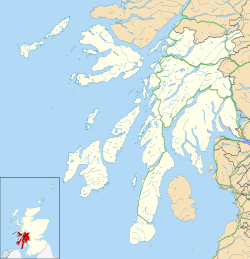| Argyll Hotel | |
|---|---|
 The Argyll Hotel, pictured in 2022 | |
| General information | |
| Location | 54 Argyll Street, Dunoon, Argyll and Bute, Scotland |
| Coordinates | 55°56′54″N4°55′28″W / 55.948433°N 4.924502°W |
| Technical details | |
| Floor count | 3 (4 in the tower) |
| Other information | |
| Number of rooms | 33 |
| Number of restaurants | 2 |
| Website | |
| Official website | |
The Argyll Hotel is a hotel located on Argyll Street in Dunoon, Argyll and Bute, Scotland. It is a Category B listed building built in the mid-19th century. [1]
Contents
The building's tower, at the southern end of the building, was added in 1876. [1] There has been an extension on its northern side, and a two-storey addition on the eastern side, connected to the main block by a curved wing. [1]
The hotel has 33 bedrooms and two restaurants. [2]



